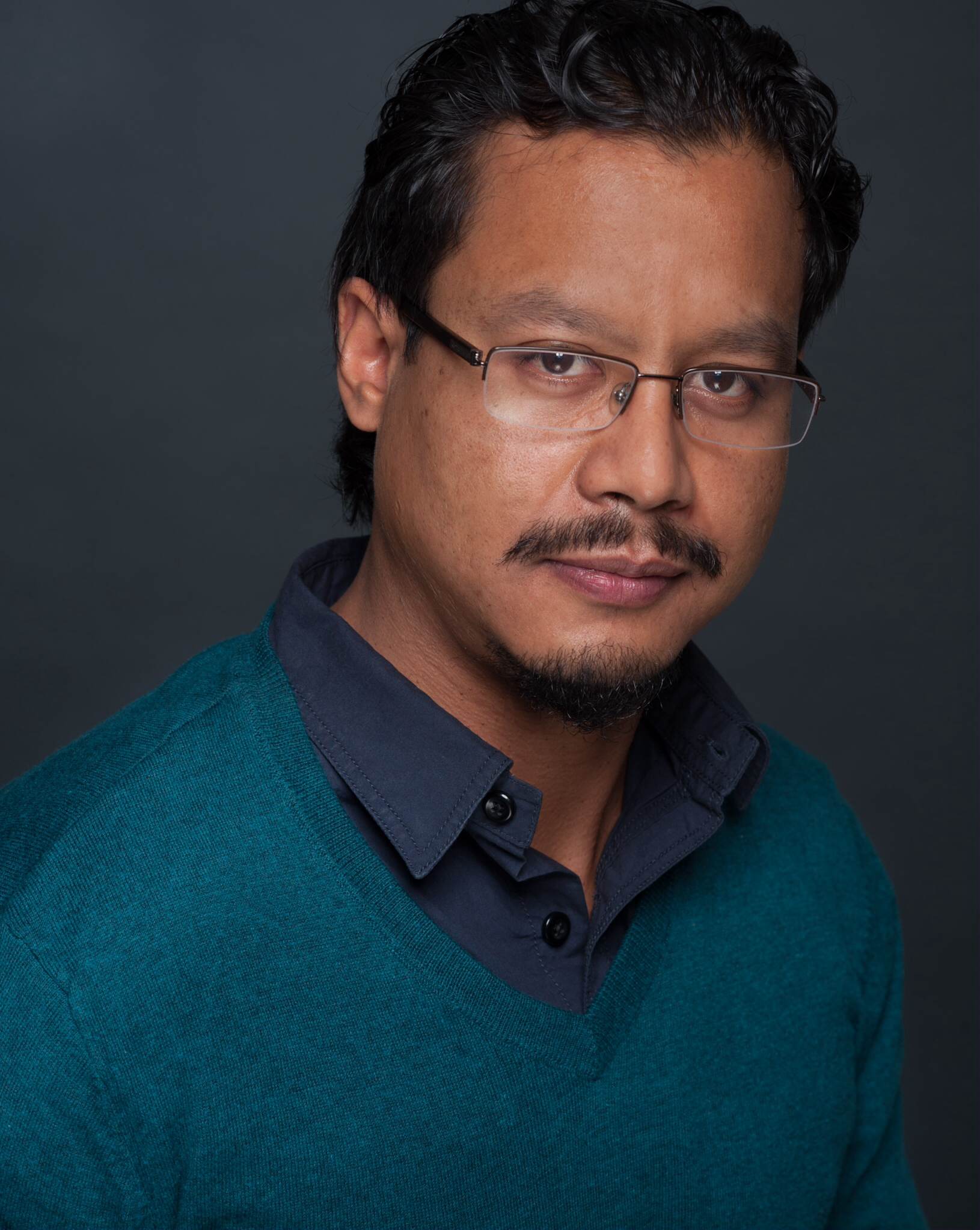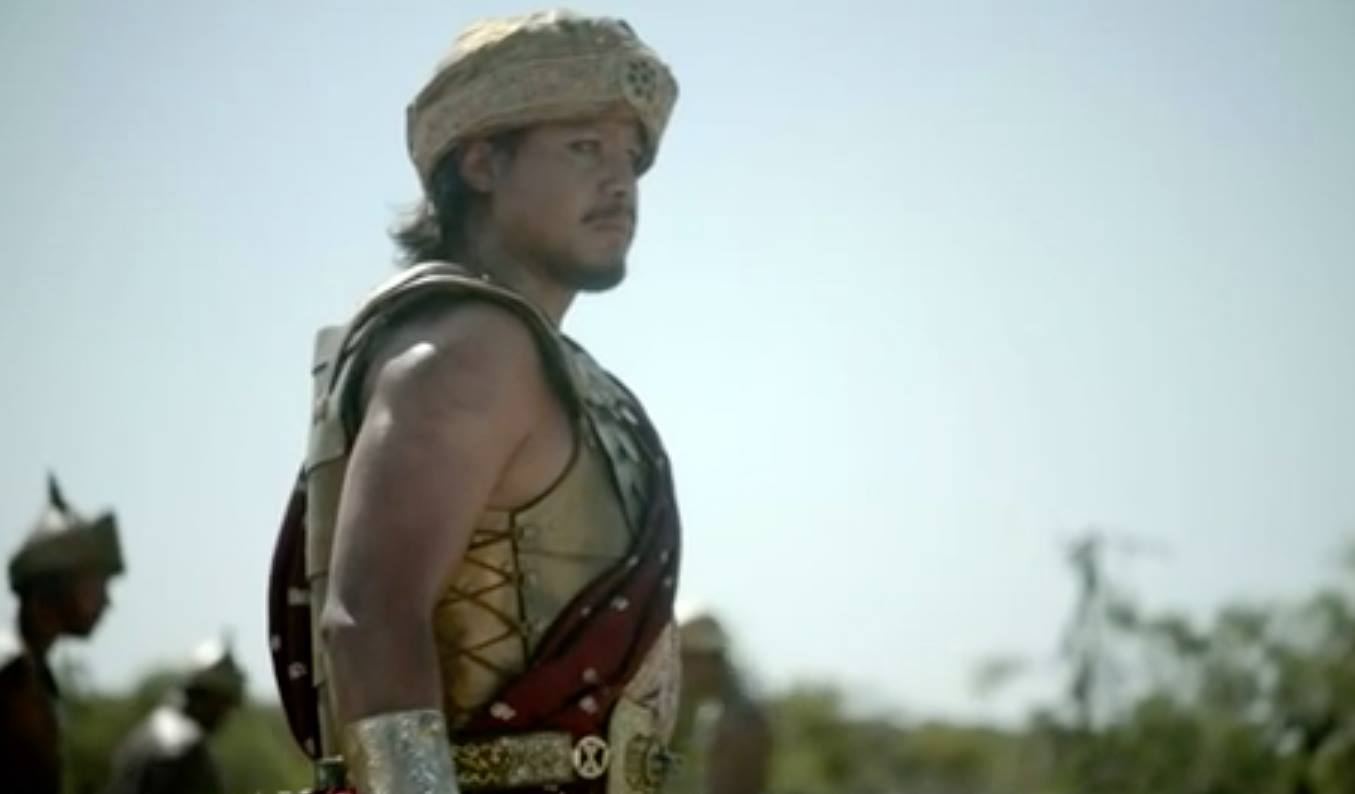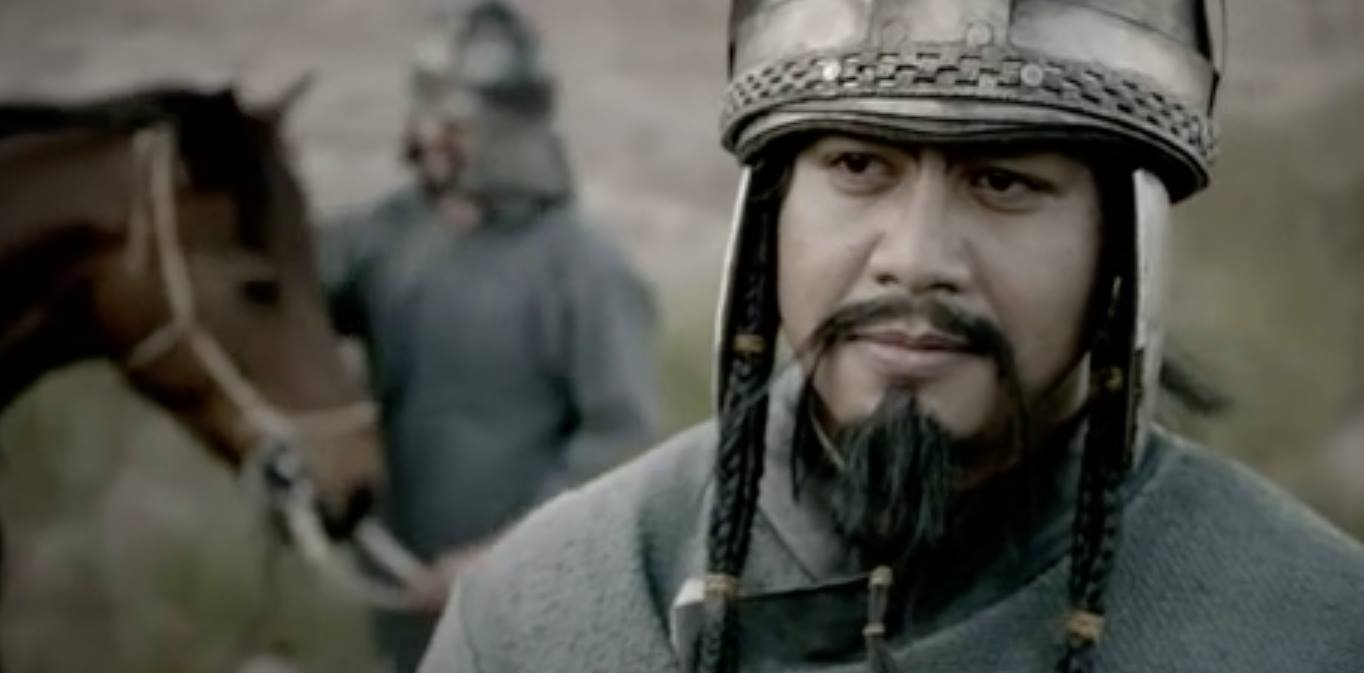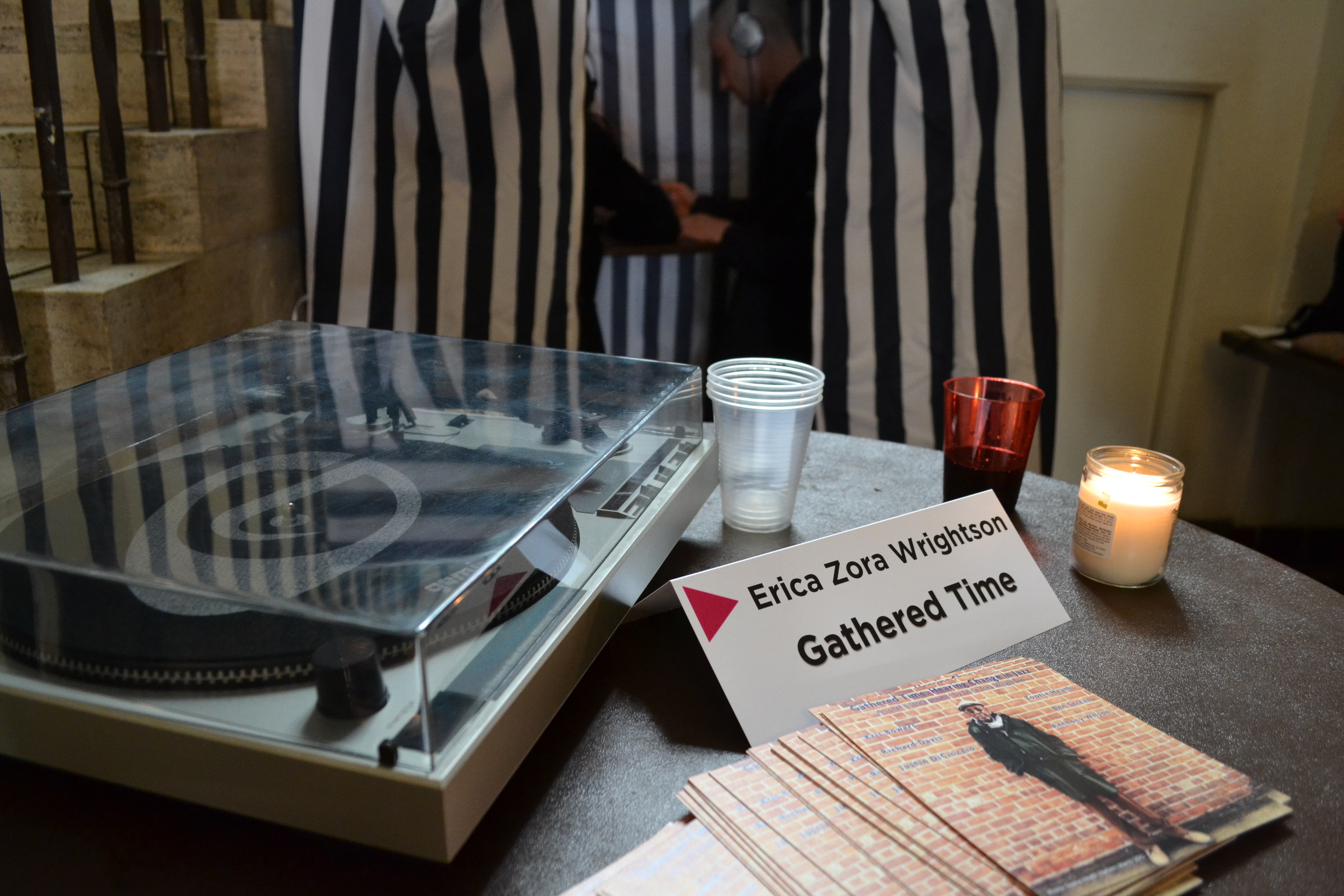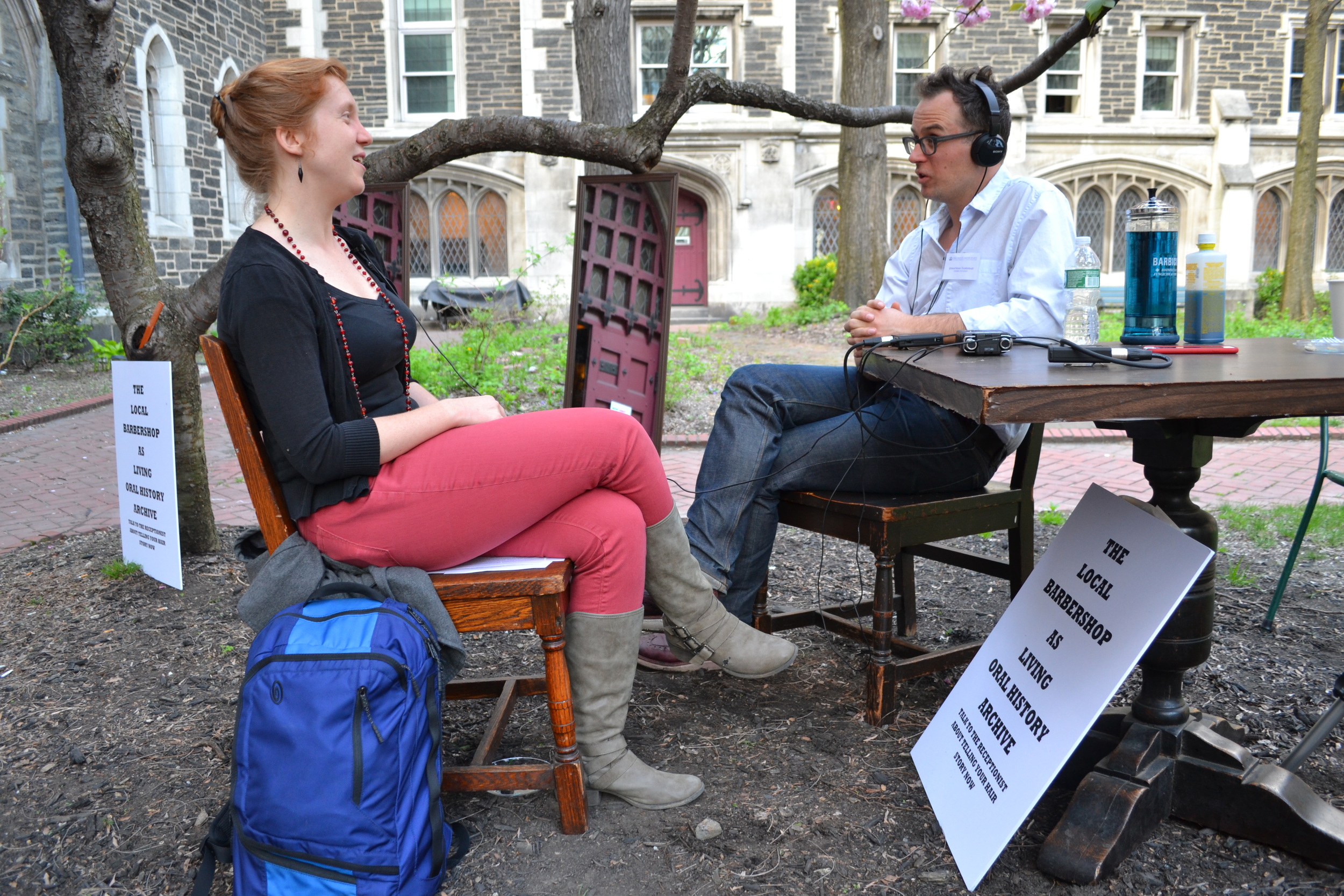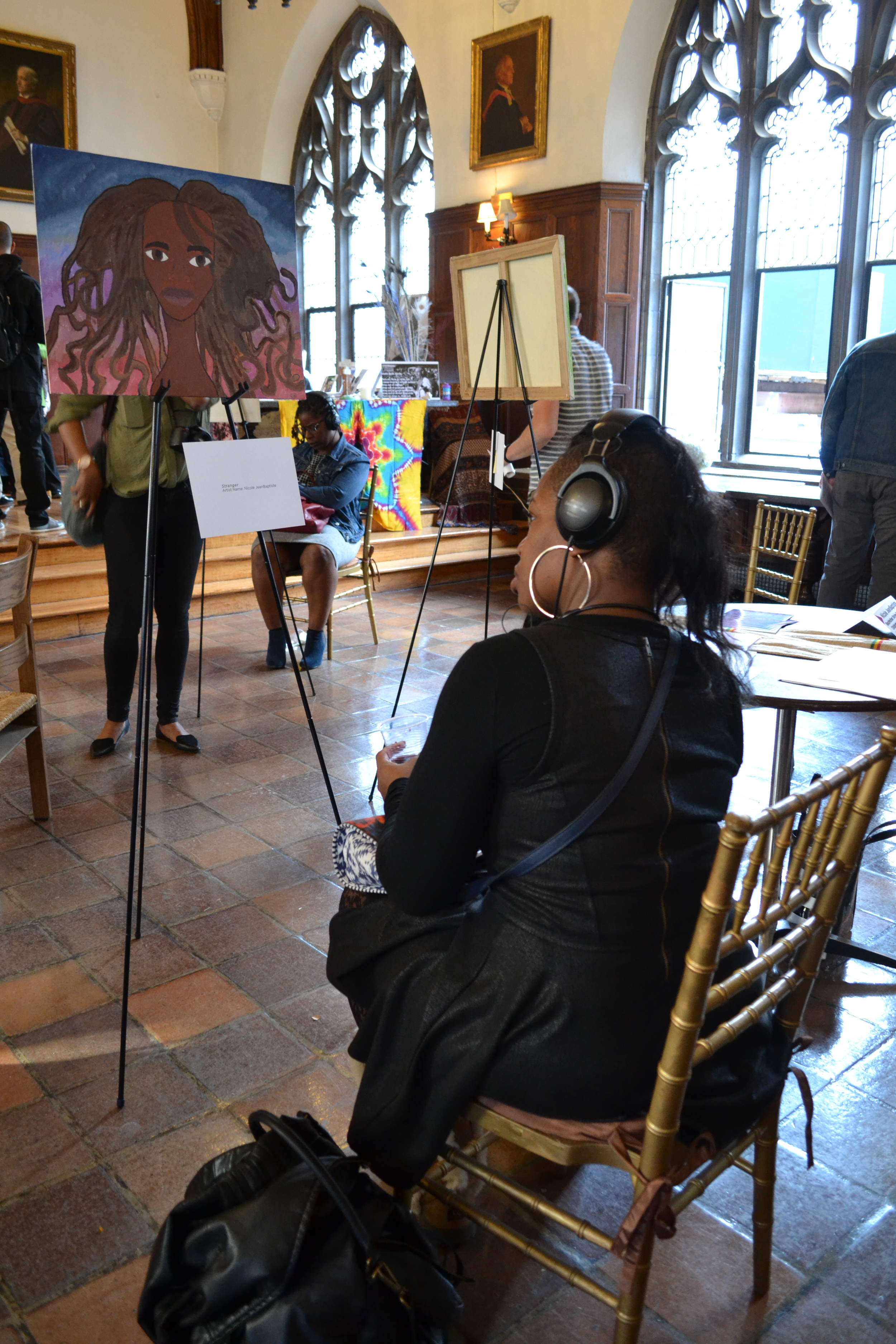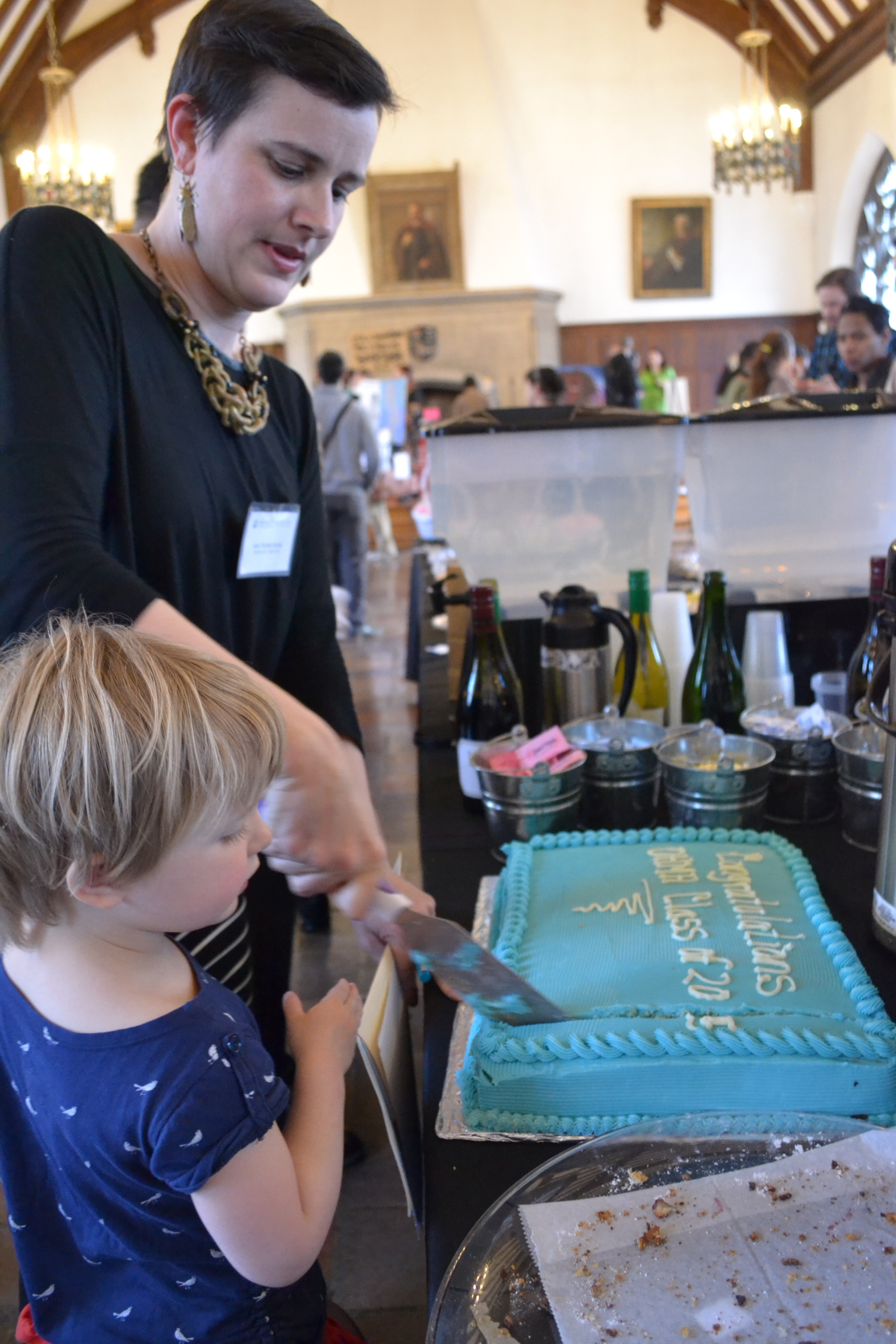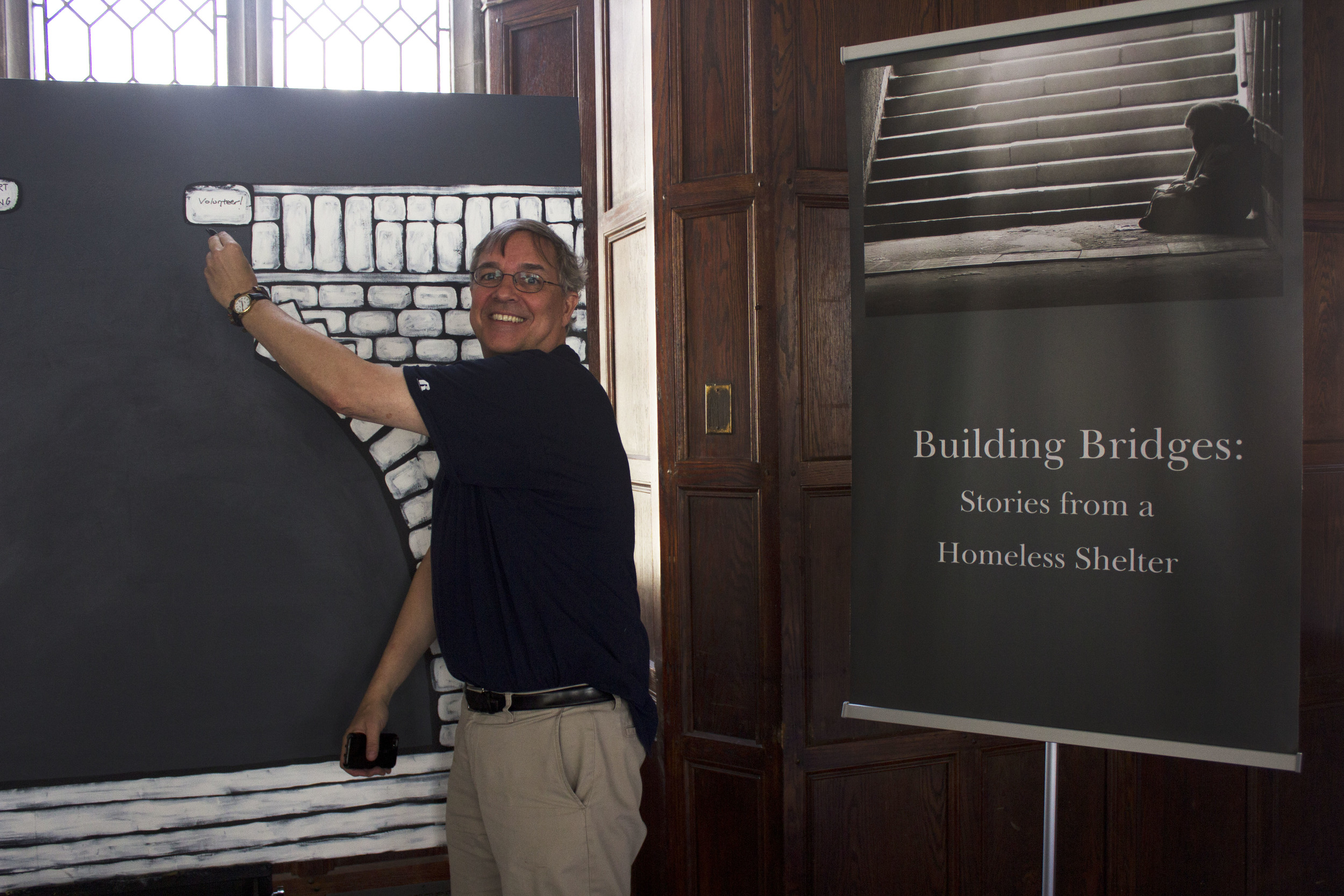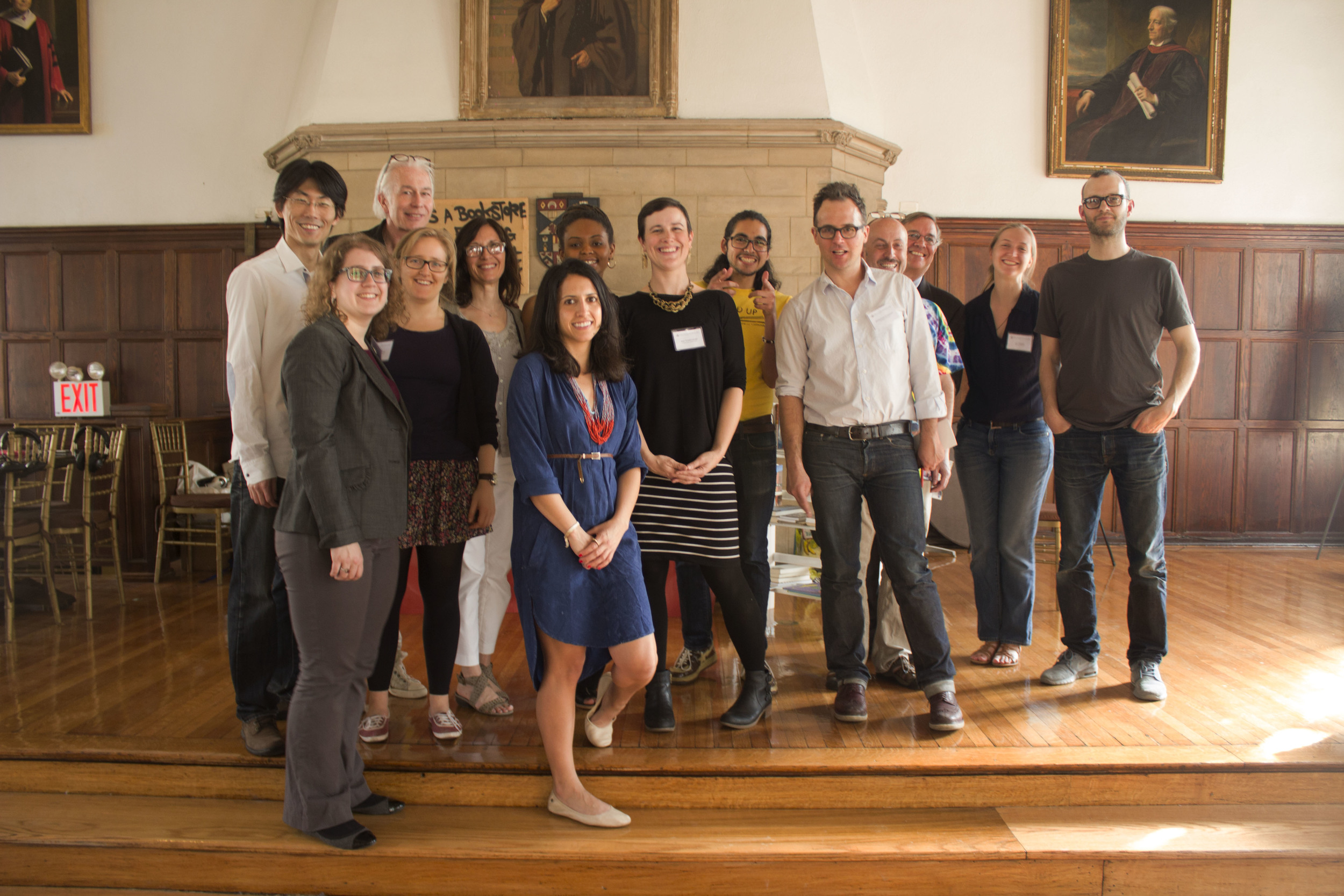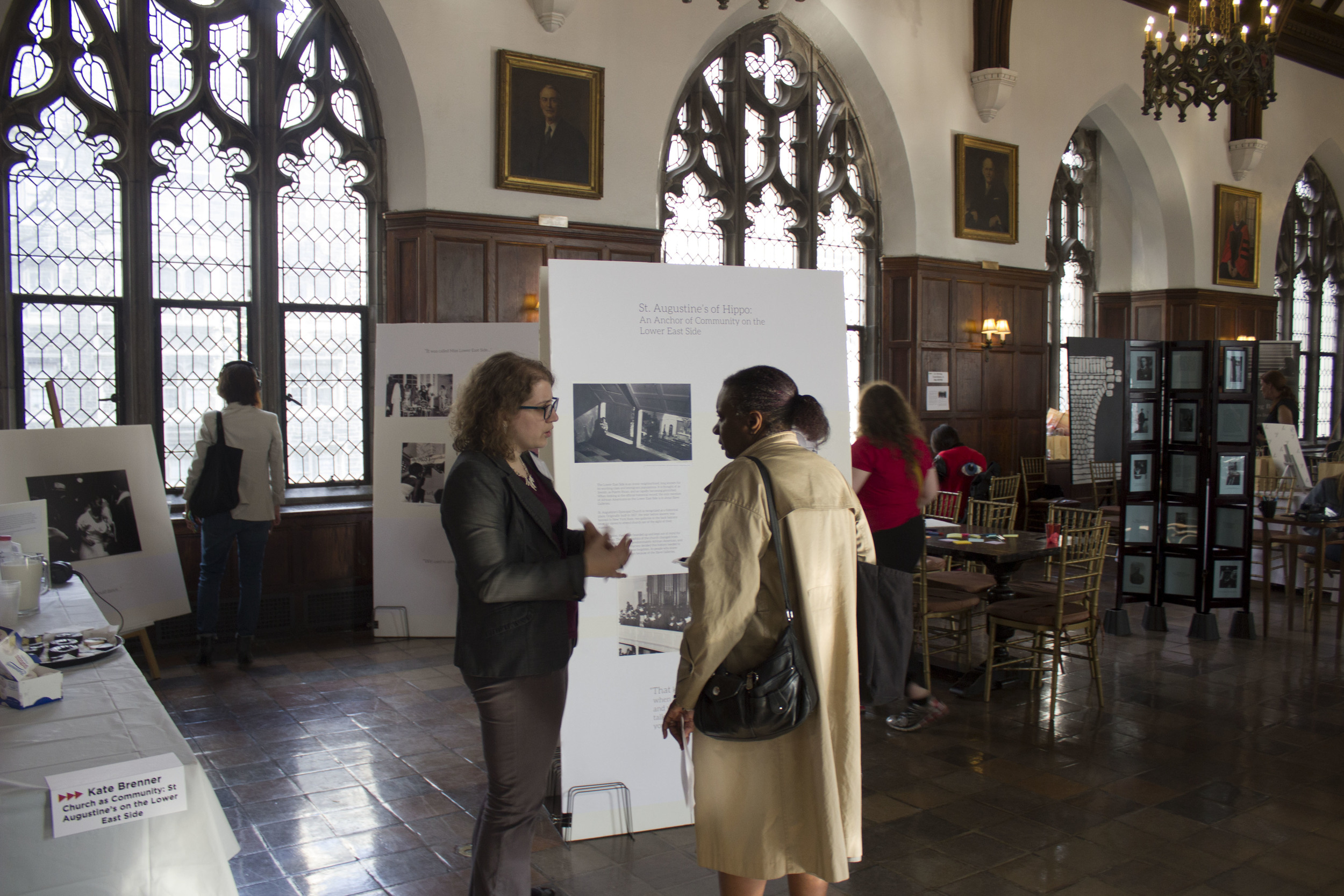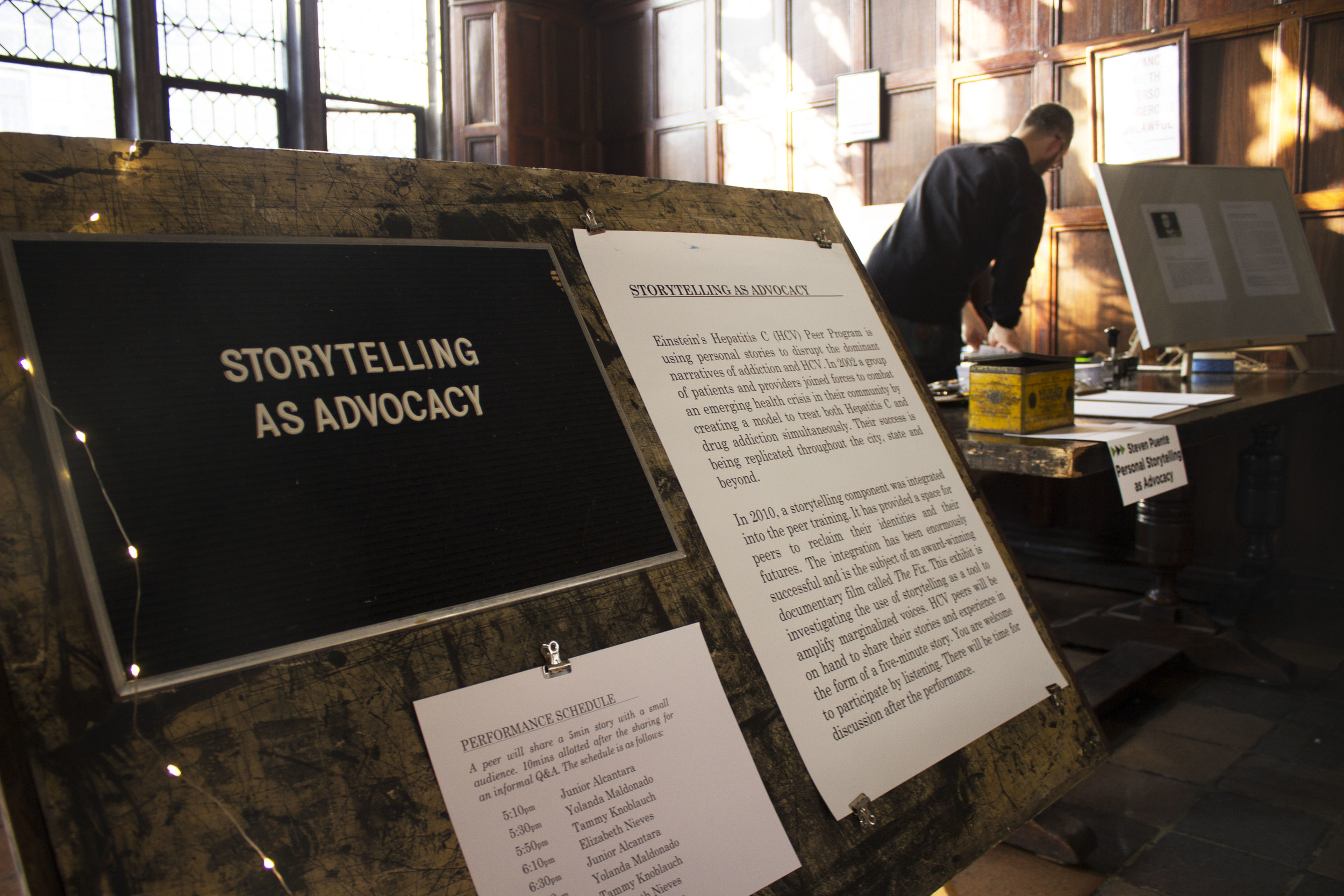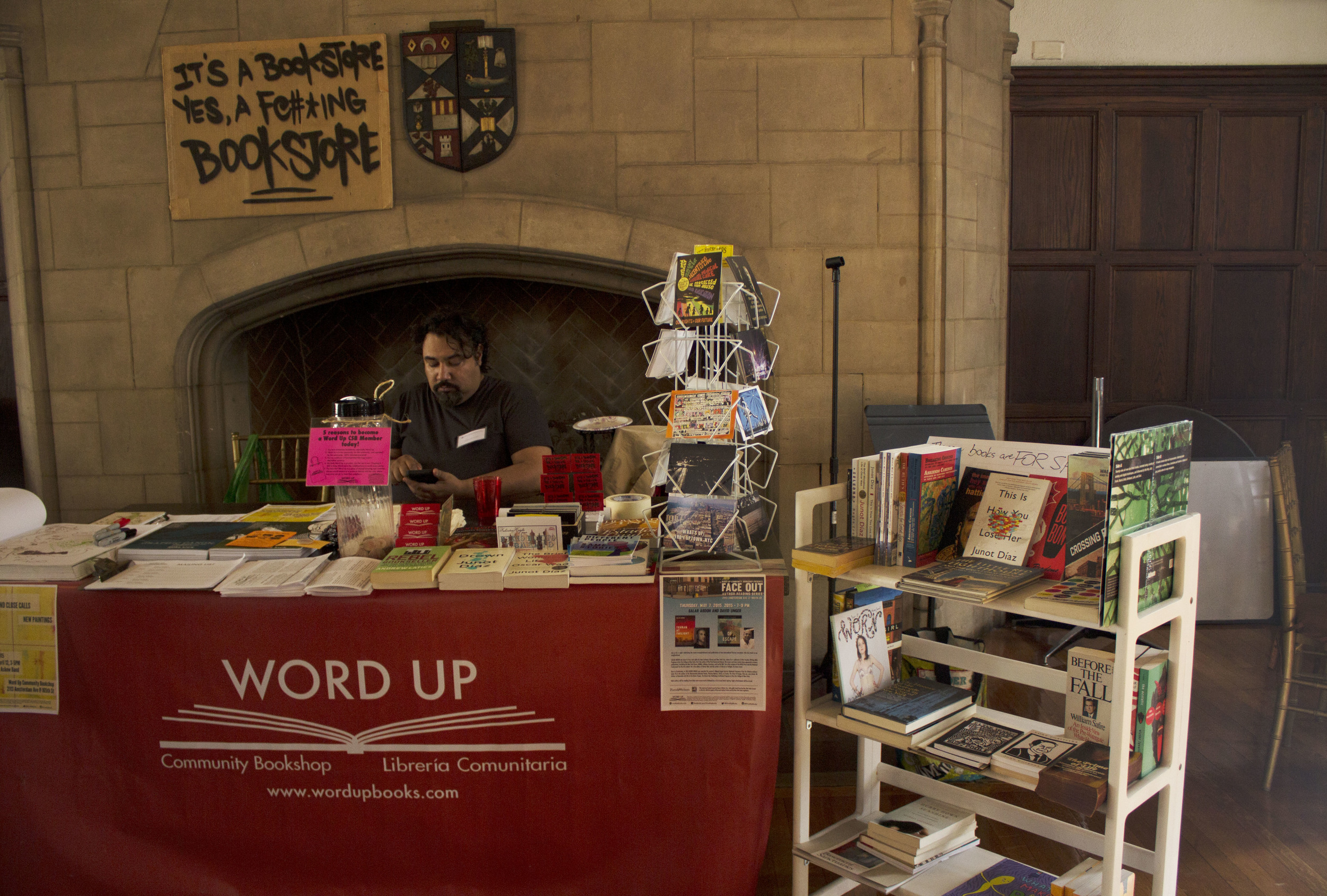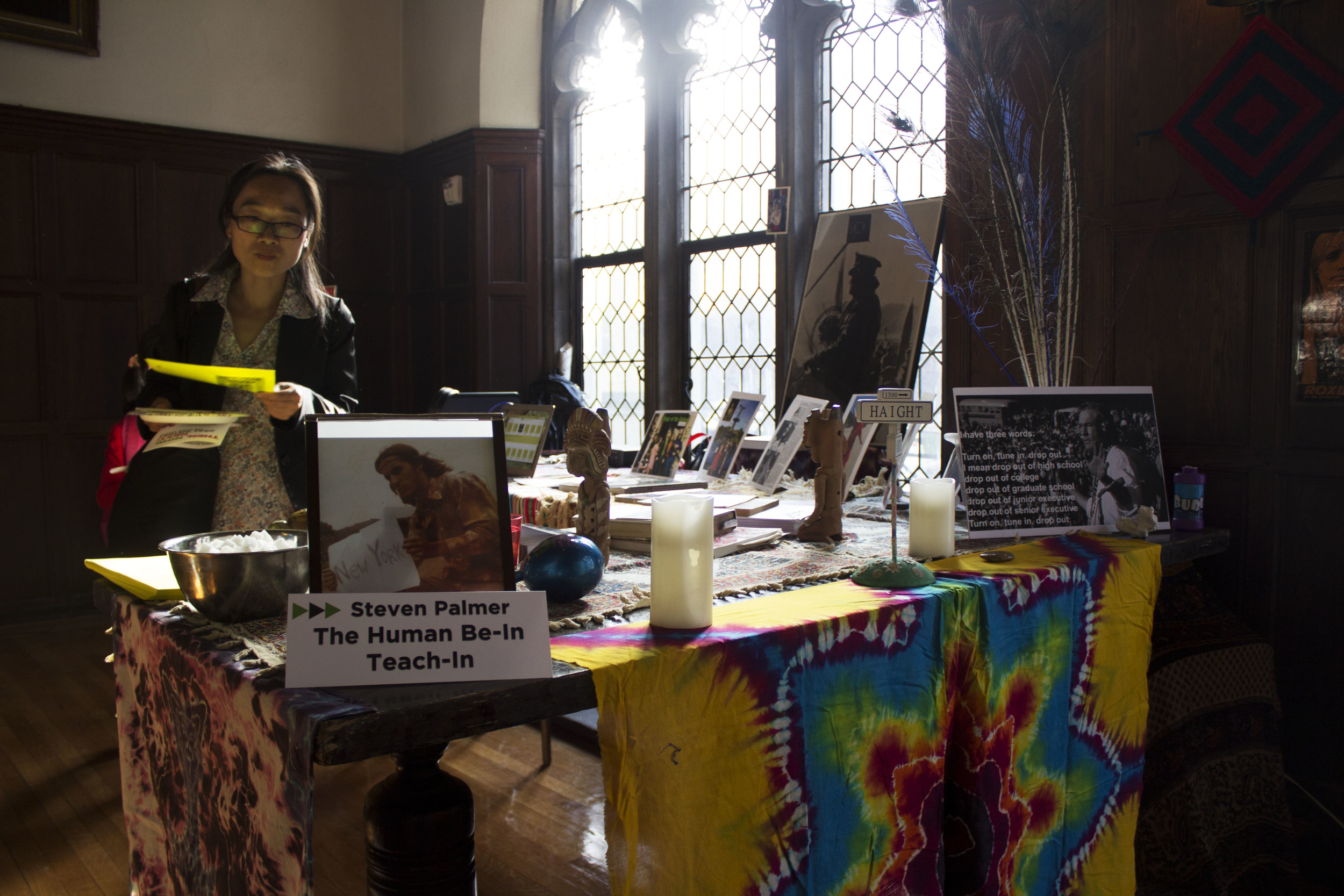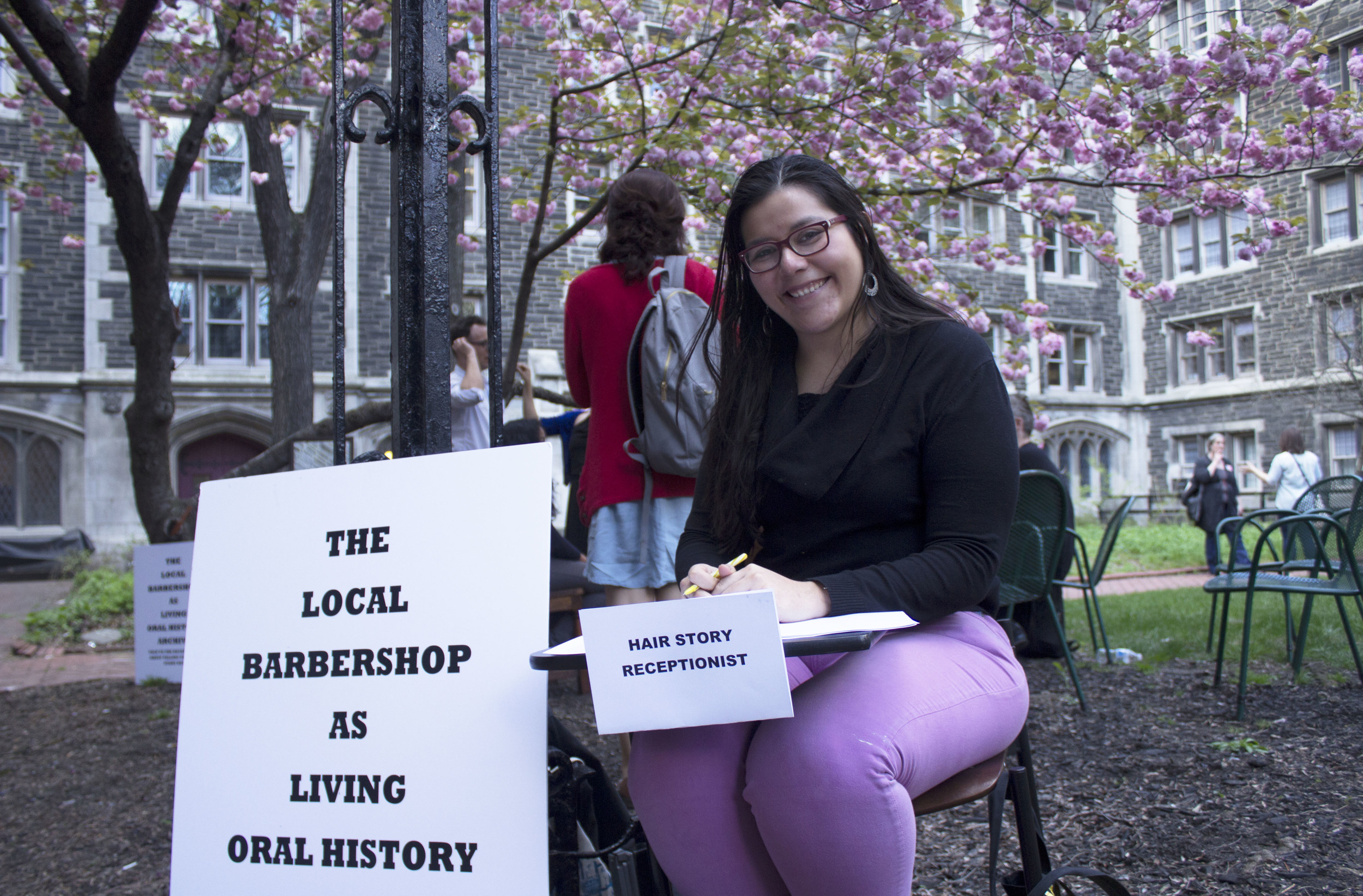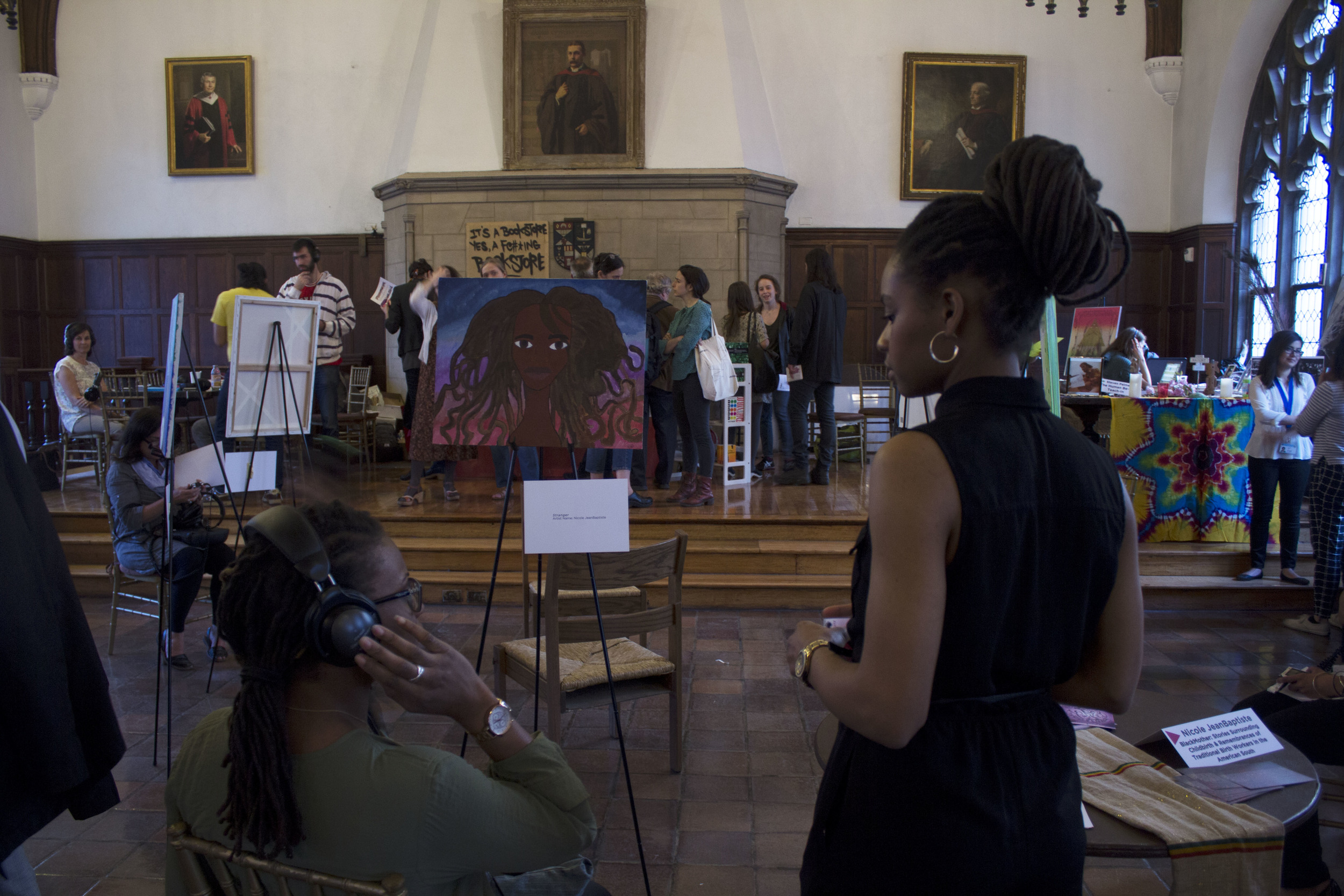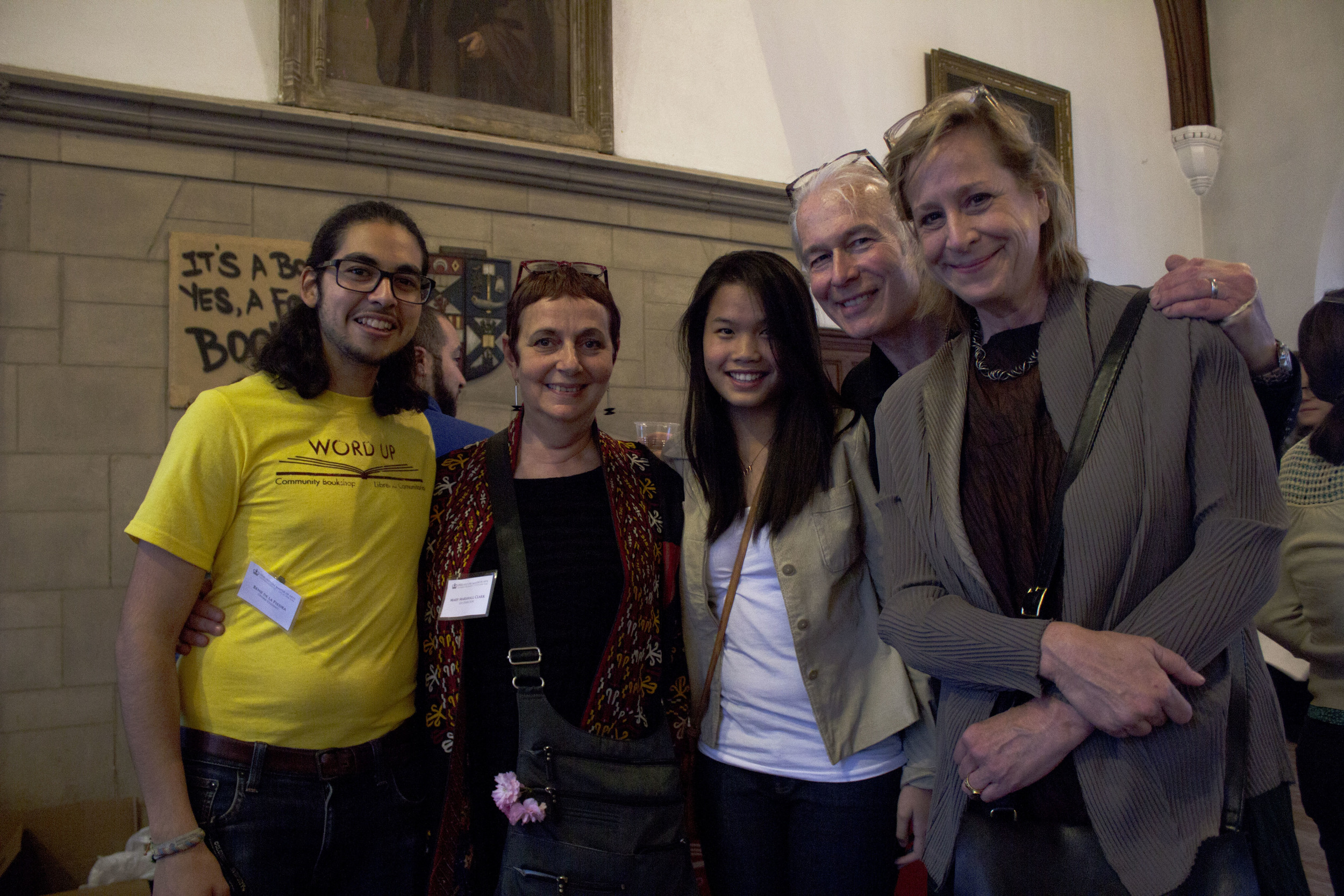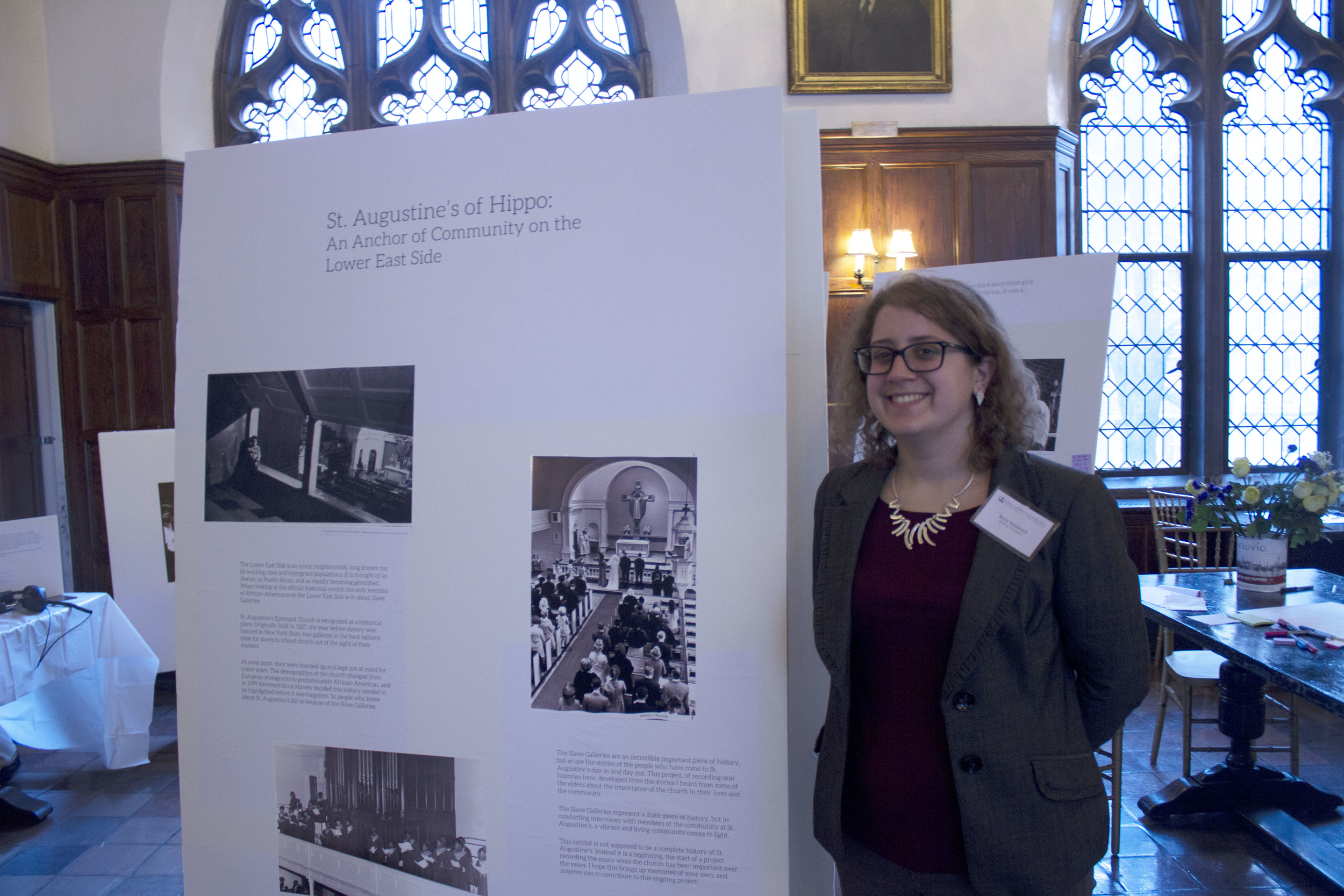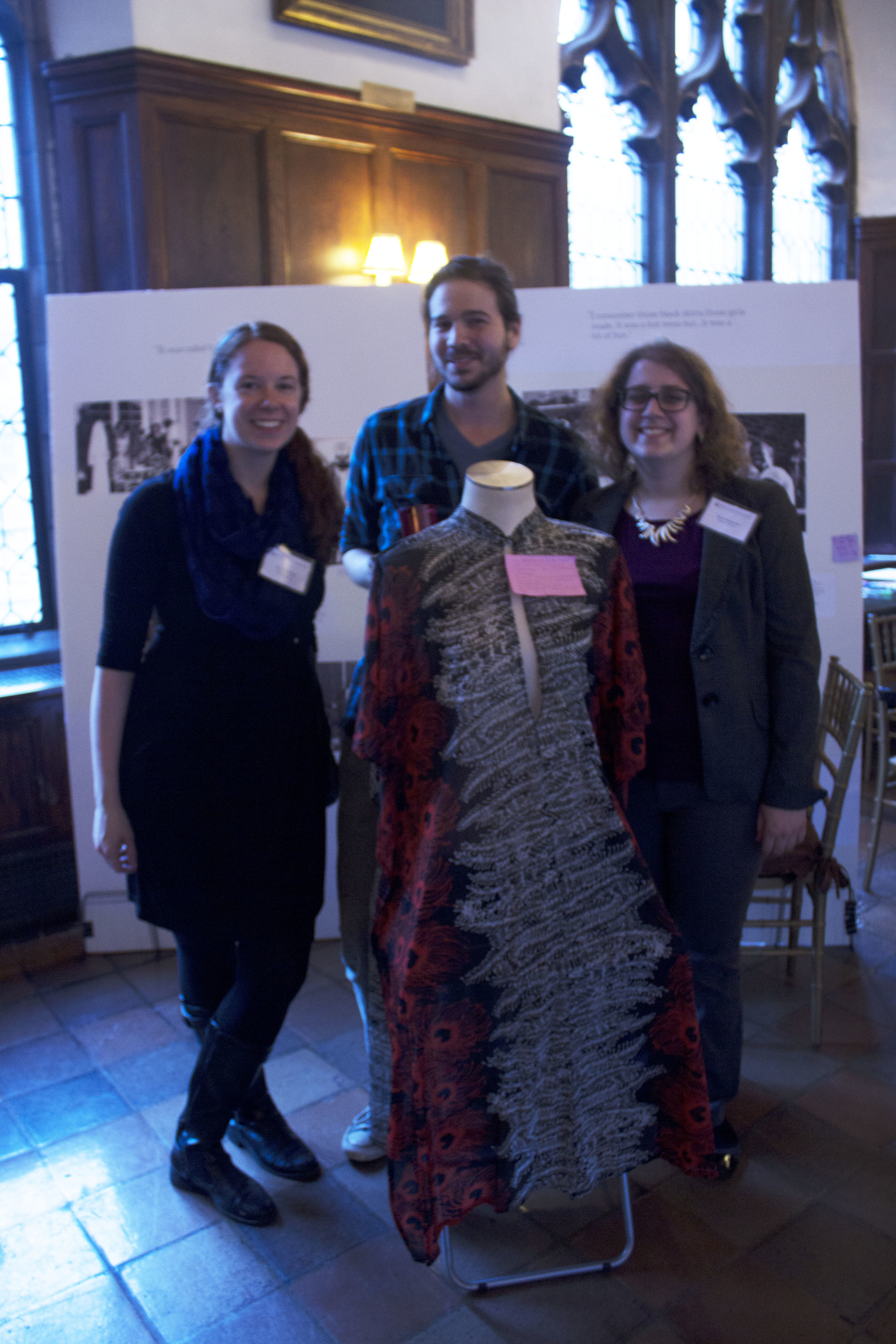Erica Fugger is an OHMA alum and the Administrative Coordinator for OHMA. In this post, she profiles 2015-2016 Oral History Merit Scholarship recipient Tauriq Jenkins.
Read MoreAlumni News
Our alums continue to demonstrate oral history’s ability to enhance work in diverse fields. Check out these Fall 2015 updates on what some of them are up to.
Read MoreFrom New York City to Oklahoma, OHMA to Anthropology
Miriam Laytner is an OHMA alum and a graduate student in Anthropology, studying stories of storms, drought and other severe weather events at the University of Oklahoma. In this post, she describes the transition from OHMA to a PhD program in Anthropology.
Read MoreThoughts on Pursuing a Career in Oral History
Jacob Horton '14 is an OHMA graduate and intern with the Nantucket Historical Association's library. In this post, he reflects on careers in the field of oral history.
Read MoreTalking About Love: documentary interview styles
Liz Strong is a current OHMA student. In this post, she looks at interview tactics in documentary film.
Read MoreHow to Get a Grant
Steven Puente is a current OHMA student. In this post, he describes his visit to the Foundation Center Library, located in New York City.
Read MoreThen, Now, Next: Photos from OHMA's Year-End Exhibition Event
On April 29, our Oral History Masters' students and faculty curated an immersive and impressive space for sharing the stories that they collected through their research this year. Check out the photos below!
Photos by Erica Fugger and Brian Buckley.
Read more about the event.
Oral history invites us in
Audrey Augenbraum is the communications and outreach coordinator for OHMA, CCOHR, and INCITE. A native of New York City, she is constantly surprised by the important and oft-neglected facets of her community that OHMA students illuminate. In this post, she reflects on witnessing preparations for OHMA's April 29 year-end event, Then, Now, Next: Oral History and Social Change.
Read MoreAlumni News
This week we’ve had quite a lot of alumni announcements to share with our readers:
Alumna Sara Cohen Fournier contributed to a recently published collection of articles, entitled Beyond Testimony and Trauma: Oral History in the Aftermath of Mass Violence (ed. Steven High). The book surrounds ways to engage dealing with trauma and moving beyond in long form oral histories. It is based on the research "Life Stories of Montrealers displaced by war, genocides and human rights violations," which took place for 5 years in Montreal and collected stories from Rwanda, Haiti, Holocaust, and North African Jewery.
Alumna Liza Zapol has been working in collaboration with artists on a project on Embodied Mapping in the Lower East Side, sponsored by iLAND and the Lower Manhattan Cultural Council. This weekend (Friday, April 17 and Saturday, April 18, 2015) they will be hosting a symposium about this work and you can participate in some collaborative workshops for free. Check it out!
On May 14th and 15th, the Manhattan Repertory Theatre in New York is hosting full productions of alumnus Sam Robson’s play Timothy and Mary. Robson wrote the play based on oral history interviews he conducted for his OHMA thesis, for which he interviewed people with dementia and their family members and caregivers.
Alumna Sarah Loose, co-founder of Groundswell: Oral History for Social Change, was awarded the Radcliffe Oral History Grant this year. Her project, Breastfeeding & Migration, explores the connections between motherhood and migration—specifically the impacts of immigration and immigration policy/enforcement on infant feeding practices. Using a combination of oral history, photography, community organizing, participatory research and popular education, the project aims to:
- document and share the experiences of immigrant mothers (especially low-income and undocumented immigrant mothers),
- identify barriers to immigrant parents’ right to choose how to feed their infants and potential solutions, and
- support the efforts of immigrant mothers in advocating for their health, the health of their babies, and their basic human rights, dignity, and self-determination.
Ultimately, Breastfeeding & Migration seeks to contribute to organizing efforts at the intersections of gender and racial justice, workplace and immigrant rights, and maternal, infant and public health.
Alumna Elisabeth Sydor is hosting a staged reading of her thesis, Stories from the Carriage Trade, on Saturday, April 25, 2015 at 8 pm. Hear inside tales of the carriage business in the 1980’s, when Hell's Kitchen's horse-drawn carriages still trotted the streets of New York City any time of the day or night. The evening will be narrated by former carriage drivers Dave Forshtay, Maggie Goodman, Bryan Northam, Åsa Jahnke Stephens, and Elisabeth Sydor - from the book of their oral histories and Elisabeth's written recollections, developed from her masters thesis for OHMA. Free admission and no minimum, but purchase of drinks/dinner go toward the room rental - much appreciated!
Alumna Crystal Baik will be the keynote speaker at Williams College's Asian American Popular Culture conference this week (sponsored by Asian Americans Students in Action, or AASiA)-- one of the first Asian/American studies conferences organized by small liberal arts colleges in the Northeast.
Alums Erica Fugger and Anna Kaplan were elected to the board of Oral History in the Mid-Atlantic Region (OHMAR) at their annual conference last week!
At the OHMAR conference, April 9 and 10, 2015. Left to right: Erica Fugger, Cameron Vanderscoff, Cameron Donald.
It’s a pleasure to see our alums’ innovative work flourish in such a diverse array of fields—from dance, to theater, to pure oral history!
News Brief: The Latest in Oral History VI
Kate Brenner is a current OHMA student. Hailing from the frozen tundra of Wisconsin, she spends a lot of time laughing at New Yorkers who complain about the cold, and generally bemoaning a lack of availability of cheesecurds. When she's not busy perpetuating stereotypes about Midwesterners, she explores the dynamics of group interviews and story circles to better capture the history of a community.
The last round-up I did was thematic, and while I was planning on making another focused one, I’ve just come across a lot of compelling projects that do not connect in any way, so this is a selection of recent items that caught my attention.
Of course the week after I do a post entirely about photography-based oral history projects, I’m sitting in the main room at the Oral History of the Mid Atlantic Region conference, and there is a presentation on The Graying of AIDS, which tells the stories of older adults living with AIDS. Originally a photography project, they began collecting stories as well and now it has morphed into this larger oral history project as well.
Read Larry's story at www.grayingofaids.org
The Museum of Modern Art in New York just opened an exhibit on Jacob Lawrence’s iconic series of paintings on the Great Migration. The exhibition website is robust, with a variety of extra media. Though most of it is recordings of songs and poems, I was pleased to see how seamlessly they integrated oral history clips in a few parts. The oral histories are taken from Behind the Veil: Documenting African American Life in the Jim Crow South, where you can actually listen to the full interviews. Furthermore, you can read about the artist himself in an oral history interview at the Smithsonian from 1968.
By Jacob Lawrence
Seeing this integration of oral history made me revisit a site we looked at in class, Goin’ North by students at West Chester University. When learning about Omeka as a platform, we used it as an example. It serves as an online archive where you can access full interviews and transcripts with both African Americans who had migrated to Philadelphia and African Americans who had been longtime residents of the city. In addition, it has various multimedia essays, incorporating video, audio, and images. They explain the different types of new technology they used to create the website, and I think it serves as an example of how interactive and engaging an oral history project website can be.
If those two websites leave you wanting to know more about the Great Migration, last semester I read The Warmth of Other Suns by Isabel Wilkerson. It focuses on the lives of three people who experienced the Great Migration in different ways, and is based on extensive interviews with them, as well as others to provide a larger historical context for the main stories. It’s been out for a few years, but if you haven’t read it, it is beautifully written and incredibly compelling, and I cannot recommend it highly enough.
Forty years after the fall of Phnom Penh, the oral history project Transmissions 2015 is showcasing interviews with survivors of the Khmer Rouge that were conducted by young relatives of theirs, in order to combat the silence within families around that history.
Oral history projects often focus on the impact of an event on those who experienced it, but the Children of Holodomor Survivors Oral History Project looks at the impact of that event on survivors’ children.
Many museums incorporate and search out oral history to add to their collection, but the Jackson Hole Historical Society and Museum is going a step further, and showing their dedication to acquiring interviews by closing the museum for the entire month of April to focus on allowing members of the community to come by and record oral histories.
Because oral histories are primary sources, used by people other than their creators, there’s the possibility for them to be used in ways the creator may never have expected. I was bored and searching Kickstarter for projects, and while nothing came up for “oral history,” when I searched “folklore,” this comic book based on the folklore of ex-slaves as found in the WPA slave narratives came up. I’m sure neither the interviewers nor the narrators ever thought their stories might someday contribute to a comic book, but I think it’s awesome and shows the manifold uses for interviews.
Not so dirty after all
Leyla Vural is a current OHMA student. In this post, she discusses the use of the interview in the new musical Pretty Filthy.
Read MoreOpen House for Asian American Oral History Collective
Cindy Choung, an OHMA alum, is holding an open house for the Asian Oral History Collective on April 11, 2015. Don't miss it!
Read MoreNews Brief IV: Visual Oral History
Kate Brenner is a current OHMA student. Hailing from the frozen tundra of Wisconsin, she spends a lot of time laughing at New Yorkers who complain about the cold, and generally bemoaning a lack of availability of cheesecurds. When she's not busy perpetuating stereotypes about Midwesterners, she explores the dynamics of group interviews and story circles to better capture the history of a community.
The saying may be “a picture speaks a thousand words,” but when combined with oral history, a photograph can say so much more. I began thinking about the marriage of photographs and oral history when looking at the incredibly popular Humans of New York. I was really hoping I could construe it as a type of oral history, but I watched some videos about how he got the quotes that accompany the photos, and most come from very brief conversations. I decided to try to search out some ways that were more explicitly using oral history with photography.
Fortunately, my classmate Liz has already done some of the work for me. Last semester, after a lecture on two different oral history projects focusing on AIDS, she wrote this post about the use of photography to humanize and break down stereotypes about people who are HIV positive, as well as people with breast cancer.
Though I normally seek out articles about oral history, the following just popped up in my Facebook newsfeed one day. In New York, the juxtaposition between those who have (a lot) and those who don’t can be very stark, as one real estate agent realized. She became frustrated with the disparity between the luxury apartments she was showing and the people living on the streets around them, so she started buying them coffee and listening to their story.
Winona, 44. www.coffeewiththehomeless.com.
The New York Times’ Lens Blog has showcases gorgeous photos and the stories behind them. Margo Cooper’s interest in the blues, and the realization that many musicians were getting older and had stories to be documented, led her to use both photography and oral history. Her website only displays the photos, but this article has brief excerpts from the musicians.
Shine and Sam Carr. By Margo Cooper
Unfortunately, most photography oral history projects I come across online are physical exhibitions, but so interesting that I still want to highlight them. This one is outside of New Orleans, but it addresses concerns about changes in the environment of the Gulf Coast with a combination of paintings and photos of the river and oral histories by those interact with it, with the hope that the images and stories will allow visitors really see how much the environment has changed, and be able to connect to the impact that land loss has on the culture.
Asher Milgate photographed Wiradjuri elders who had grown up in an Aboriginal mission in Wellington, and interviewed them about their lives. While this is also a physical exhibit, there are a few photos online with short quotes. The exhibit in Dubbo uses audio and video as well as the photographs.
By Asher Milgate
Most movie theaters are generic boxy buildings with multiple screens, but I grew up also watching movies at the Oriental Theater in Milwaukee, a theater from 1927. Benita VanWinkle started photographing old movie theaters to document them before they all disappeared, but realized that the people who would go there also had stories about the importance they had in their lives that were just as important to preserve as the architecture.
This is what I’ve been able to find so far, but would love to know about more photography-based oral history projects. Several weeks ago, a guest blogger with OHMA told us about her fledgling oral history project as archivist for the organization Professional Women Photographers. If you know of any, leave them in the comments!
Stories from the Carriage Trade: A Staged Reading
OHMA alum Elisabeth Sydor will host a staged reading of her thesis.
Read MoreNews Brief: The Latest in Oral History III
Kate Brenner is a current OHMA student. Hailing from the frozen tundra of Wisconsin, she spends a lot of time laughing at New Yorkers who complain about the cold, and generally bemoaning a lack of availability of cheesecurds. When she's not busy perpetuating stereotypes about Midwesterners, she explores the dynamics of group interviews and story circles to better capture the history of a community.
Technically I’m supposed to find projects and write about them, but I found this blog post on Northwest History that talks about Spokane’s Pride, an LGBT oral history project. He discusses the project and even highlights a few more LGBT oral history projects. The rest of his blog might be of interest as he is a public historian and assistant digital archivist who uses it to “explore the intersections of public and digital history."
The U.S. Naval War College just completed a 20 year oral history project with women who were in the Women Accepted for Volunteer Emergency Service (WAVES). There’s no audio online, but the full transcripts are there so you can learn about another facet of American military history.
If you’re interested in oral history of people in religious orders, and happen to be in Peoria, you can stop by this exhibit, which features a few oral histories with older priests. No matter where you are, you can listen to these clips of interviews with nuns.
Oral history can make for great performances. Here one town, inspired by StoryCorps, is collecting stories of residents and producing a play. Of course, oral histories of significant events can contribute to a more well rounded production, as it does in this project, which addresses the impact of World War I in England both nationally and locally.
The Catskills are suffering from what has been deemed a heroin epidemic. The Kingfisher Project is an attempt to use oral history and storytelling to report on the problem, as well as to fight it.
Though I didn’t know much about the partition of India, I’ve heard about the 1947 Partition archive before. I think this article really sums up the importance of the archive as a record of the largest mass migration in history.
This wasn’t a very audio-heavy list, so I’ll end with an assortment of short clips from Columbia’s archive. Enjoy listening to people from Thurgood Marshall to Dorothy Parker.
News Brief: The Latest in Oral History II
Kate Brenner is a current OHMA student. Hailing from the frozen tundra of Wisconsin, she spends a lot of time laughing at New Yorkers who complain about the cold, and generally bemoaning a lack of availability of cheesecurds. When she's not busy perpetuating stereotypes about Midwesterners, she explores the dynamics of group interviews and story circles to better capture the history of a community.
As much as it’s fun to read about oral history, it can also be nice to revel in the actual orality of it. So here are links that (mostly) have an oral component for you to listen to.
I may be biased because I read some of Listening on the Edge for a class, but here’s an opportunity to listen to the two authors discuss their opinions on interviewing people closely after an event, as well as the impact on the interviewer.
If you listen to Radio Diaries you may have already heard this, but I just started listening, and was very excited when I listened to their podcast from last September. It has 2 previously unpublished oral histories conducted by Studs Terkel for his Working series, one with a taxi driver, the other with a parking attendant.
Speaking of Studs Terkel and Working, did you know they made it into a musical in the 70’s? I did not, but a school in California recently performed it, and a blogger mused upon the relevance of performing it today.
The New York Public Library is embarking on a massive oral history project on living in New York. Here they’ve assembled a sampler of clips to pique your interest in interviews about life in Greenwich Village, Harlem, Morris Park, as well as the experiences of being blind in the city. Listen to them and then explore the full interviews available on each project’s website.
This essay from Transom about perception of voices on NPR was published in multiple places on the internet, inspiring a lot of different conversations. One was orchestrated on twitter by NPR’s Code Switch blog team. It was also a topic of discussion on one of my favorite podcasts, NPR’s Pop Culture Happy Hour, where they took into consideration all different types of voices and the general perception of them on the radio.
February was Black History Month, so a lot of links in my Google alert were specifically related to that, which is great, but wouldn’t it be cool if African American history wasn’t highlighted for just one month? The Visionary Project looks at the lives of African American Elders. Each person’s page has a brief biography, and then a selection of clips to watch from their interview. It’s really well organized and seems like it would be a great teaching tool to use all year.
Despite being a self-avowed nerd, I have never watched Star Trek. But after the death of Leonard Nimoy, this segment of his interview with the Yiddish Book Center’s Wexlar History project describing exactly his inspiration for the Vulcan hand gesture was widely circulated on the internet.
Gender at Work Storytelling Events
Gender at Work and the Women's Rights Storytelling Collaborative Initiative, two Center for Oral History community partners, have several events coming up!
News Brief: The Latest in Oral History
Kate Brenner is a current OHMA student studying the history and importance of St. Augustine's Church in the African American community on the Lower East Side of New York City. In our new series, Kate marshals new developments related to oral history.
One of the exciting things about the field of oral history is that it has such broad applications, what you can do with it seems endless. Of course, that also means there’s a lot of oral history- related content available. I have put my fondness for reading things on the internet to use, creating a highly subjective roundup of interesting oral history- related links. Some I picked for the topic, some for the application, all because I found them intriguing. This weekly list is only a tiny fraction of what I come across from my Google alert, links from classmates and professors, and what I stumble upon naturally.
As an oral historian, and someone who has worked with K-8 students, I think it’s great to see oral history being used to engage kids. This article uses Black History Month to highlight the Children’s Oral History Project at the African American Museum of Iowa as an educational tool, where the interviews (both video and transcript available) are conducted by kids.
Oxford University Press did a follow up Q and A with Katie Kuszmar, the author of From Boat to Throat: How Oral Histories Immerse Students in Ecoliteracy and Community Building, going into more depth about her experiences of doing oral history projects with students.
An intern at the Southern Oral History Project shares her reflection on working with the oral histories there, and emphasizes that their archives are accessible online for anyone to browse.
After the death of Norman Bridwell, the author of the beloved Clifford children’s books, a museum in Martha's Vineyard decided to curate an exhibit on pets, including clips of oral histories where people talked about their animals.
While many people know StoryCorps, they might not know about the different initiatives they have. Some have been highlighted in the news recently, including telling stories of Latin@s, LGBT stories, and soon StoryCorps will be telling New Orleans post-Katrina stories, with an emphasis on getting a broad spectrum of people to come and share their experiences.
Since moving to New York from Wisconsin, I’ve discovered just how homogenous people assume the Midwest is, so it’s great to see there’s a new oral history book documenting Hmong lives in Michigan. As a bonus, the author even included a few recipes for the reader to try.
Oral history is often used for institutional histories, but I never considered focusing on the oral history of a relatively small hospital in Virginia. It’s a topic I didn’t expect, but it allows you to take a look into healthcare, and the interviews are all right there for you to watch.
Another easily accessible online collection, this one chronicles the oral history of dance in Western Australia.
Oral history has the capacity to be used for really interesting creative pieces. "Vignettes: Ellis Island," takes stories from the Ellis Island Oral History Project, turning the journey to America into a musical piece, one that many listeners were able to personally connect with.
Technology is a neverending subject of discussion for oral history, but sometimes even simple shifts can make it much more accessible. The Cultural Landscape Foundation is moving its videos to YouTube, making them viewable on your phone. This is especially relevant because their videos talk about architects and their work, so now you can stand in a place while hearing someone talk about it.
Apply now for the Columbia Center for Oral History Research's 2015 Summer Institute on Population Health
The Columbia Center for Oral History Research housed at INCITE is pleased to announce its 2015 Oral History Institute, “Narrating Population Health: Oral History, Disparity, and Social Change,” to be held June 15-26, 2015 at Columbia University in New York City. Increasing economic disparities, war, political conflict and identity-based forms of discrimination have resulted in an unprecedented global crisis in equitable health practices and the distribution of resources. Specifically, we will look at concrete ways that oral history reveals those disparities within communities that face discrimination and stigma, and offers new paradigms for understanding and response.
Areas of focus will include: HIV/AIDS, mass incarceration, reproductive rights, harm reduction, addiction, stigma and discrimination and the impact of the built environment on health such as asthma and other diseases. The program will focus on ways that scholars and advocates have used oral history to illuminate the impact of inequitable distribution of health resources in local and global communities.
The program will hold workshops on interviewing, analysis, digital oral history applications, and interdisciplinary research methods with presentations from medical researchers, historians, population health experts and sociologists. We encourage applicants to use the Institute to explore a range of oral history-research applications, and will select participants based on a successful pairing of the oral history method with other modes of inquiry and analysis in engaging the topics of population health from interdisciplinary perspectives.
The 2015 Application is Now Open
Priority will be given to applications submitted by February 28
Applications must be submitted no later than April 15
Tuition for the Institute is $2,200. Fellowships are available. Visit CCOHR's website for more information, including a list of faculty. For any inquiries, please email ccohr@columbia.edu.
Faculty will include:
Mary Marshall Clark, Director of the Columbia Center for Oral History Research and co-director of the Oral History Master of Arts Program at the Interdisciplinary Center for Innovative Theory and Empirics of Columbia University
Gerald Albarelli, Professor of Writing, Sarah Lawrence College
Peter Bearman, Director of the Interdisciplinary Center for Innovative Theory and Empirics, co-director of the Oral History Master of Arts Program, co-director of Robert Wood Johnson Health and Society Scholars Program, and Member of the National Academy of Sciences
Doug Boyd, Director of the Louie B. Nunn Center for Oral History at the University of Kentucky Libraries
Terrell Frazier, Education and Outreach Director, Columbia Center for Oral History Research
George Gavrilis, Research Fellow, Institute for Religion, Culture, and Public Life at Columbia University
Ronald J. Grele, Director Emeritus of the Columbia Center for Oral History
Alondra Nelson, Dean of Social Science, professor of sociology and gender studies, and director of the Institute for Research on Women, Gender, and Sexuality at Columbia University
David Rosner, Ronald H. Lauterstein Professor of Sociomedical Sciences and Professor of History at Graduate School of Arts and Sciences at Columbia University
Linda Shopes, Former President of the U.S. Oral History Association, Freelance Editor and Consultant in Oral and Public History
Amy Starecheski, Associate Director of the Oral History Master of Arts Program at the Interdisciplinary Center for Innovative Theory and Empirics of Columbia University
Keith Wailoo, Townsend Martin Professor of History and Public Affairs and Vice Dean of the Woodrow Wilson School of Public and International Affairs at Princeton University
OHMA alum Nicki Pombier Berger will teach workshop at 2015 Oral History Summer School
OHMA alum Nicki Pombier Berger will teach a workshop, Memory Loss and Mixed Ability Interviewing, at this summer's Oral History Summer School in Hudson, New York.

